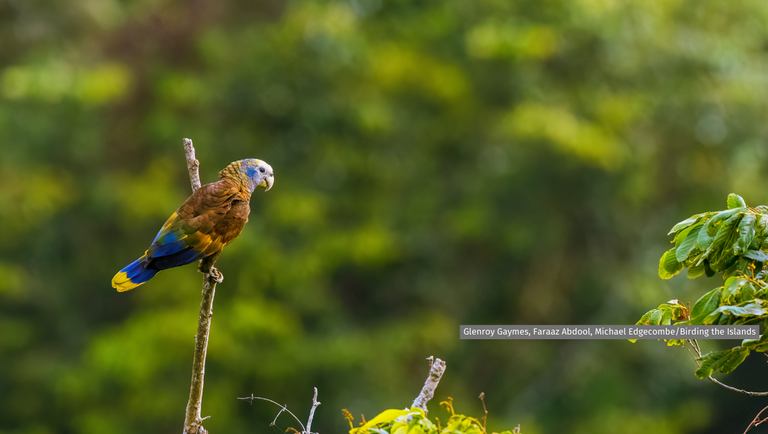Notícias
Study maps animal species at risk of extinction due to natural disasters

Around 10% of terrestrial vertebrate species are at risk of extinction in the coming years due to natural phenomena such as earthquakes, hurricanes, volcanoes and tsunamis. There are almost 4,000 potentially threatened species exposed to these events, with a significantly higher prevalence on islands and in tropical regions. The conclusions can be found in an article published on June 17 in the scientific journal Proceedings of the National Academy of Sciences (PNAS), signed by researchers from 20 foreign and Brazilian institutions, including the Center for Research on Biodiversity and Climate Change (CBioClima) of the São Paulo State University (Unesp), Rio Claro campus, the Vale Institute of Technology (ITV), the University of São Paulo (USP), the State University of Campinas (Unicamp), the State University of Santa Cruz (UESC) and the Rio de Janeiro Botanical Garden Research Institute.
The scientists mapped how the occurrence and magnitude of these natural phenomena overlap with the distribution areas of amphibians, birds, mammals and reptiles. To formulate the list of animals that are threatened by new occurrences of these phenomena, the authors selected species that have less than a thousand individuals in the wild or species that live in a considerably small area, less than 2,500 square kilometers - in other words, species that will have difficulties reproducing and, consequently, recovering the viability of the population in the face of critical natural events.
The Neotropical region, which stretches from southern Mexico to northern Argentina, is home to almost 40% of the threatened species, according to the study. Most species are susceptible to hurricanes, in the Caribbean Sea and the Gulf of Mexico, and to volcanoes, earthquakes and tsunamis in the regions of the Pacific Ring of Fire. The results indicate that 70% of the most susceptible species are restricted to islands. This is the case of the Saint Vincent parrot (Amazona guildingii), native to the densely forested mountains of the Caribbean island of Saint Vincent, in the Lesser Antilles. The species is classified as being at high risk from volcanic activity and at risk from hurricanes. The work also highlights that around 30% of the species live completely outside protected areas, which could further increase the risk of extinction due to the great human impact on unprotected areas.
Researcher Fernando Gonçalves explains that species such as the panda bear, originally from China, and the sapphire-bellied hummingbird, found in Colombia, are at risk of becoming extinct due to these natural phenomena. According to his assessment, only two species in Brazil are at risk, since these events are not frequent in Brazilian territory: the sand lizard (Liolaemus lutzae), which lives on the coast of Rio de Janeiro, and the red-bellied toad (Melanophryniscus cambaraensis), which lives between the states of Santa Catarina and Rio Grande do Sul. The analysis took into account the low-magnitude tsunami that hit the coast of Rio de Janeiro in 2004 and the low-magnitude hurricane that hit the southern region in the same year.
Gonçalves points out that when earthquakes, hurricanes and tsunamis happen in Brazil, they are generally of low magnitude. "Despite not being located near the edges of tectonic plates, where most earthquakes occur, Brazil still has geological faults that can generate seismic activity," explains Gonçalves. "As for tsunamis, when they do occur, they are usually associated with localized events, such as underwater landslides and/or distant earthquakes."
The study's conclusions highlight the need for intensive and urgent action to conserve these species and their environment. "In addition to human impacts, the frequency and magnitude of climate-driven natural phenomena, such as hurricanes, are expected to increase in the coming years," recalls Gonçalves. The researcher stresses that the impacts of these events on biodiversity, although still little studied, can be significant.
"This is an unprecedented study, bringing the risk of extinction due to natural phenomena to species that are threatened by other forms of human action, such as deforestation and habitat loss. The good news is that we can mitigate these risks with concrete conservation actions," says researcher Carine Emer, a research associate at the Rio de Janeiro Botanical Garden. She adds that the method is valid for other groups, including plants, however, the limitation to applying this method is the data. "We work with secondary data (i.e. data that has already been collected) and, in the case of plants, most of the information on home ranges and numbers of individuals in the wild is lacking or absent. Many other groups besides plants also have this problem, such as fungi, insects and all forms of microorganisms. Hence the importance of field expeditions to collect primary biodiversity data that can serve, among other things, to fill in the gaps in knowledge in terms of the distribution and population size of species from the deficit groups," concludes the researcher.